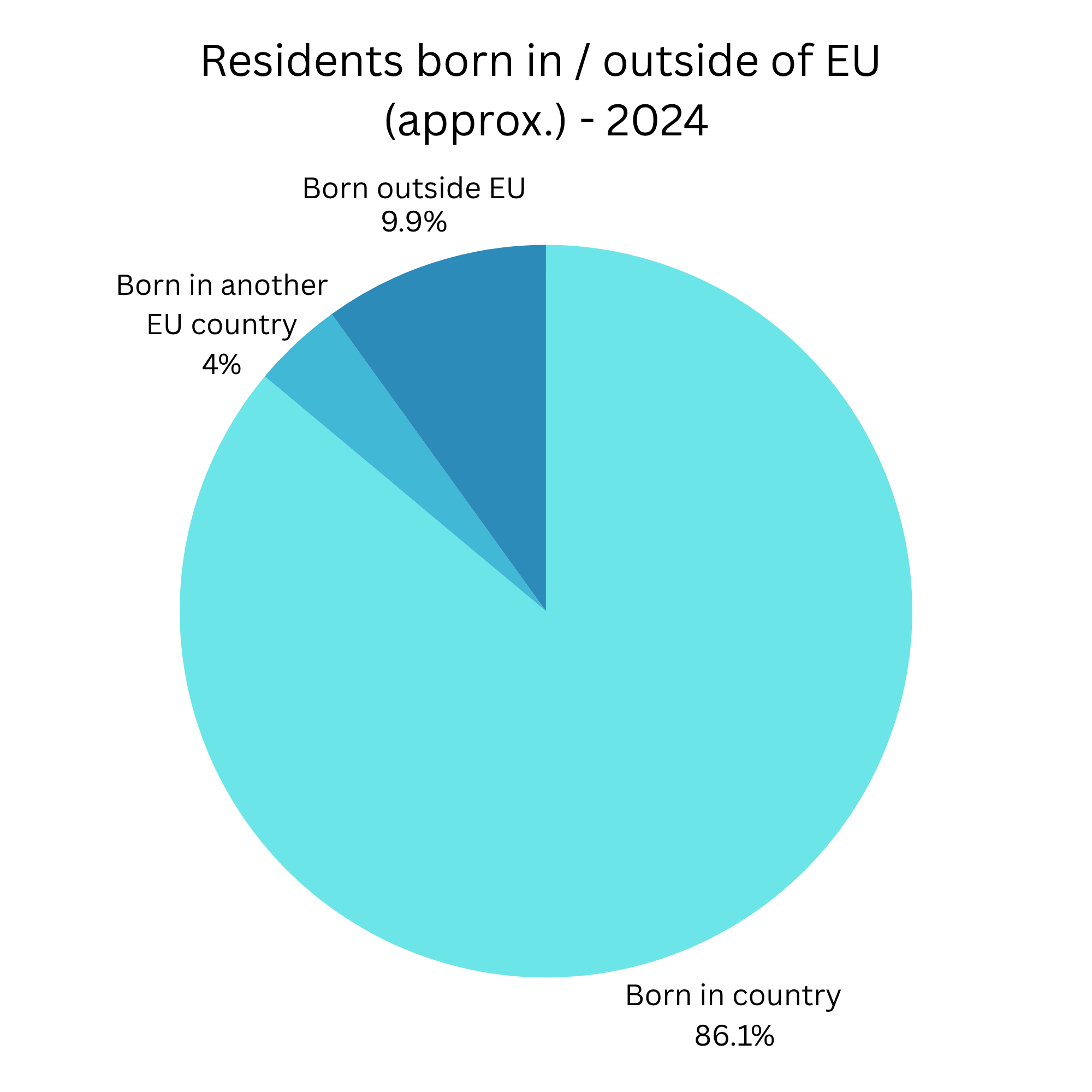DURATION
approx. 20 minutes
FORMAT
Interactive + text-based
The goals of this module
Understanding the benefits of migration in Europe and the EU
Being able to promote and explain the benefits of migration in Europe to others
What is it about?
In this module, you will learn more about what benefits of migration are, especially for the European Union. Thus, we will present you with a look into what migration means in the European Union, where migrants are active and how they contribute to the EU.

Population statistics

Citizens living in the European Union in 2024
29.0 million people (6.4%) of the 449.3 million people living in the European Union (January 2024) were non-EU citizens. This means, that they were neither from the country they were residing in, nor from another EU member state. This translates to 1 in every 16 people is a migrant. If that sounds like a lot, maybe this can give you something to rethink that:
- 1 in every 5 people in the EU is aged 65 or older
- 1 in every 16 people in the EU has diagnosed diabetes (around 35 million people)
- 1 in every 6 people in the EU has a diagnosed mental health disorder (counted annually).
Compared to these statistics, migrants do not seem as common as some might think. Especially while there are areas (often urban areas) where migrants gather due to the possibilities and access to everything, there are locations where there is little migration as well (more rural areas).

Where are residents in the EU actually born
Out of all 449.3 million EU residents (not citizens), 44.7 million people (or 9.9%) are people who were born outside of the EU.
Out of the same 449.3 million EU residents, 17.9 million people were born in another EU member state than they one they are residing in. While the first number is higher, this highlights the notion that EU migration is not just third-country nationals or migration from outside the EU but there is also a lot of migration inside of the European Union itself.

Non-national born per country
Migration differs a lot per country. We know that the border countries of the European Union see a lot more migrants than inland countries (with exceptions) while some countries are also more likely to have migrants, due to other conditions, such as France, due to many non-EU countries speaking French. Therefore, making France a preferred choice for migration as they do not have to learn a new language.
In numbers only, the highest share of foreign born individuals in an EU country, is Germany with having over 6 million people born in another EU member state, and over 10 million people born outside of the EU. This is followed closely by France, Italy and Spain, with all three countries having over 1 million other EU-country born residents, and over 5 million non-EU born residents each.
Taking in comparison to the population itself, there are countries where over half or a third of the population are foreign-born: Luxembourg (51.0% of the resident population), followed by Malta (30.8%), Cyprus (26.9%), Ireland (22.6%), Austria (22.1%), Sweden (20.6%) and Germany (20.2%).
Migrants in the labour market



Dependency on migrant workers
Despite the myth of “migrants taking our jobs”, migration and migrant workers are often a fundamental part of a working labour market. In some countries, such as Luxembourg, over 46% of jobs in the service sector are filled by migrants (albeit migrants from other EU countries) but also countries such as Malta have 15% of their labour force in the service sector filled by migrants. And they are not the only countries who have high numbers of migrant employees. Often migrants (whether EU nationals or not) fill job vacancies which national citizens are over- or underqualified for or even just do not want to fulfill. But imagine what would happen if all migrants suddenly weren’t a part of the labour force anymore? The consequences would be dire.



The dependency of the agricultural sector
The statistics become even more surprising when taking a look at a different sector: the agricultural one. 7% of Spain’s jobs in agriculture are filled by EU national migrants and 15% even by nationals from non-EU countries. That means over 20% of the agriculture work force are non-Spanish citizens. Italy faces the same situation, albeit with 12% of non-EU nationals. With these numbers it is clear that there is a strong dependency on migrant work in agriculture.
So what if we didn’t have migration?
In the following quiz, we want you to think about what could be the effects and consequences of not having migration or not fostering integration of migrants in Europe. In case you want to know more about the topic or want to explore the answers to the quiz, feel free to read the article above.

